Ben Hedrick (talk | contribs) mNo edit summary |
Tom Sponheim (talk | contribs) mNo edit summary Tag: sourceedit |
||
| (3 intermediate revisions by 3 users not shown) | |||
| Line 1: | Line 1: | ||
{{GoogleTranslateLinks}} |
{{GoogleTranslateLinks}} |
||
| ⚫ | |||
| − | |||
| ⚫ | |||
[[Image:Wapi-before-after.jpg|right|220px|thumb|The WAPI on right shows that pasteurization temperatures have been reached since the wax has melted and moved to the bottom of the tube.]] |
[[Image:Wapi-before-after.jpg|right|220px|thumb|The WAPI on right shows that pasteurization temperatures have been reached since the wax has melted and moved to the bottom of the tube.]] |
||
A '''Water Pasteurization Indicator''' (WAPI) is a simple thermometer that indicates when water has reached pasteurization temperature and is safe to drink. It was invented by [[Fred Barrett]] and [[Dale Andreatta]]. |
A '''Water Pasteurization Indicator''' (WAPI) is a simple thermometer that indicates when water has reached pasteurization temperature and is safe to drink. It was invented by [[Fred Barrett]] and [[Dale Andreatta]]. |
||
| Line 10: | Line 9: | ||
Since [[Water pasteurization|water pasteurizes]] at temperatures well below the boiling point of water, WAPIs save time when solar pasteurizing, and save fuel when using traditional fuels. |
Since [[Water pasteurization|water pasteurizes]] at temperatures well below the boiling point of water, WAPIs save time when solar pasteurizing, and save fuel when using traditional fuels. |
||
| + | |||
| − | {{clr}} |
||
| + | Some people have wondered how long the water temperature must be maintained at the pasteurization temperature. The WAPI is designed so that if the wax melts, the water is definitely pasteurized. Also, it should be noted that the water will be slowly rising into the pasteurization zone and then slowly cooling down from the pasteurization temperature. This offers a extra layer of protection since harmful pathogens are being killed even at lower temperatures but at a slower rate. |
||
| + | |||
==Recent news and developments== |
==Recent news and developments== |
||
*'''February 2014:''' [[Dale Andreatta]], inventor of the [[WAPI]], discusses the latest developments in [[water pasteurization]] at the ETHOS 2013 conference in Kirkland, {{state|Washington}}, [[USA]]. He describes three uses for low temperature (below boiling) solar-heated water, and three simple devices for producing that hot water. In Johnson and Bryden (2012) it is estimated that in a particular village in [[Mali]], 22% of the domestic wood consumption went for water heating exclusive of cooking, while another 52% went for cooking. In a sunny climate the methods presented here would provide most of the energy required for water heating exclusive of cooking, and a substantial fraction of the energy needs for cooking. Read more at: [[Media:Solar_Thermal_Document.pdf|Solar Thermal Energy for the Village]] - ''Dale Andreatta'' |
*'''February 2014:''' [[Dale Andreatta]], inventor of the [[WAPI]], discusses the latest developments in [[water pasteurization]] at the ETHOS 2013 conference in Kirkland, {{state|Washington}}, [[USA]]. He describes three uses for low temperature (below boiling) solar-heated water, and three simple devices for producing that hot water. In Johnson and Bryden (2012) it is estimated that in a particular village in [[Mali]], 22% of the domestic wood consumption went for water heating exclusive of cooking, while another 52% went for cooking. In a sunny climate the methods presented here would provide most of the energy required for water heating exclusive of cooking, and a substantial fraction of the energy needs for cooking. Read more at: [[Media:Solar_Thermal_Document.pdf|Solar Thermal Energy for the Village]] - ''Dale Andreatta'' |
||
| Line 61: | Line 62: | ||
[[File:Tusk Trust Documentary - 07 Making Water Safe to Drink|thumb|none|425 px|Making Water Safe to Drink with the [[WAPI]].]] |
[[File:Tusk Trust Documentary - 07 Making Water Safe to Drink|thumb|none|425 px|Making Water Safe to Drink with the [[WAPI]].]] |
||
[[File:Water Pasteurization Indicator (WAPI)|425px]] |
[[File:Water Pasteurization Indicator (WAPI)|425px]] |
||
| − | [[ |
+ | [[File:Soda bottle pasteurizer made from recyclables|425px]] |
==Disposible soda straw variation== |
==Disposible soda straw variation== |
||
Revision as of 22:03, 19 August 2015
|
Last edited: 19 August 2015
|

The WAPI on right shows that pasteurization temperatures have been reached since the wax has melted and moved to the bottom of the tube.
A Water Pasteurization Indicator (WAPI) is a simple thermometer that indicates when water has reached pasteurization temperature and is safe to drink. It was invented by Fred Barrett and Dale Andreatta.
Pasteurization destroys all microorganisms that cause diseases from drinking contaminated water and milk. A small polycarbonate tube contains a wax that melts when water or milk is heated enough to be pasteurized (65˚C/149˚F). This saves much fuel by eliminating the need to boil water or milk to ensure that the pasteurization temperature has been reached. See also Instructions for building WAPIs.
Since water pasteurizes at temperatures well below the boiling point of water, WAPIs save time when solar pasteurizing, and save fuel when using traditional fuels.
Some people have wondered how long the water temperature must be maintained at the pasteurization temperature. The WAPI is designed so that if the wax melts, the water is definitely pasteurized. Also, it should be noted that the water will be slowly rising into the pasteurization zone and then slowly cooling down from the pasteurization temperature. This offers a extra layer of protection since harmful pathogens are being killed even at lower temperatures but at a slower rate.
Recent news and developments
- February 2014: Dale Andreatta, inventor of the WAPI, discusses the latest developments in water pasteurization at the ETHOS 2013 conference in Kirkland, Washington, USA. He describes three uses for low temperature (below boiling) solar-heated water, and three simple devices for producing that hot water. In Johnson and Bryden (2012) it is estimated that in a particular village in Mali, 22% of the domestic wood consumption went for water heating exclusive of cooking, while another 52% went for cooking. In a sunny climate the methods presented here would provide most of the energy required for water heating exclusive of cooking, and a substantial fraction of the energy needs for cooking. Read more at: Solar Thermal Energy for the Village - Dale Andreatta
- January 2014: North Star Devices announces a sale on the SuperWAPIs. A year-end sale set to end on December 31, 2013, is to be extended until remaining stock is gone. Regularly $225USD for 100 finished units, the price is now $199USD including extended financing options. Read about the WAPI's latest features: Reusable Water Pasteurization Indicators (WAPIS)
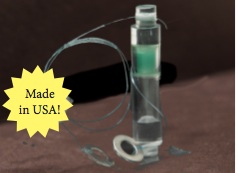
The Cool WAPI from North Star Devices, Inc.
- December 2103: Robert Nepper reports that they have made improvements to the SuperWAPI, which features a heat resistant stainless steel cable. North Star Devices' WAPI is the only WAPI offered as a hammer together design, not requiring heat sealing. The SuperWAPI is also now available as a kit. Read more about their WAPIs in their latest flyer: Reusable Water Pasteurization Indicators (WAPIs)
- November 2013: Study of water treatment in Kenya demonstrates the effectiveness of the WAPI - Bob Metcalf, research microbiologist, and FOTO worked together on a study to compare results of various water treatment chemicals to the WAPI water pasteurization indicator used with a CooKit solar cooker. One finding of note is that the WAPI, when used with the CooKit, was 100% effective in producing negative results for E.coli, while the WaterGuard (3 drops/liter) method was only effective in most cases. Read the study at: The Goal is Zero: A Strategy to Eliminate Water-bourne Disease in Lower Nyakach, Kenya
Articles in the media
- January 2010: WAPIs set to go to Haiti - Recorder Online
- May 2007: Little pieces go long way to provide safe water - Knoxville News Sentinel
- December 2003: Professor sees solar solution to safer water - Sacramento State News
Buying WAPIs
- WAPIs can be purchased from Solar Cookers International.
- The Monterey Sunrise Rotory Club sells a kit that contains the materials to make 200 WAPIs. Contact PDG Don Kremer at WAPI@pacbell.net.* North Star Devices sells WAPI assembly kits and materials.
- Sun Ovens International sells WAPIs and Solar Ovens
- The Cool WAPI design does not require heat sealing the tube, but uses a plug to seal the ends instead. See various types, and purchasing information at The Cool WAPI
Improved design
Solar Cookers International has recent started manufacturing and selling an improved WAPI design that makes use of plugs to seal the tube and a metal string that won't melt when the WAPI is used to determine pasteurization temperature when water is heated over a cooking fire.
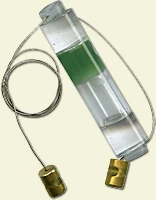
The new design uses plugs to seal the tube and a metal wire that won't melt when used on a cooking fire.
The Cool WAPI
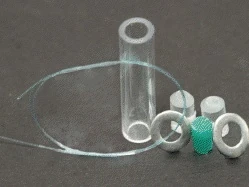
The Cool WAPI can be purchased assembled or as this kit. See various types, and purchasing information at the Cool WAPI
The new Cool WAPI, developed by Robert Nepper and Bill Stevenson, is called “cool” since it requires no heat for assembly when compared to the earlier version WAPI. We have re-designed the WAPI in response to customers who wanted it capable of being assembled in the country of use. We offer it in the completely assembled version and in the totally unassembled version, complete with all parts.
Yes, unskilled persons can assemble the new cool WAPI with a minimum of tools and instructions. All that is really needed is a common claw hammer and a heavy, flat rock, a cement block or an anvil. It must be solid and heavy or you will find it too difficult to hammer in the plugs. To prevent injured fingers, however, we offer a free simple holder set with initial purchases of 100 pieces or more. The holders also prevent the plugs from being driven in too far (obscuring the holes needed for the fish line).
We sell the completed version for $1.25 each and the unassembled version for $.95 each (in lots of 100 or more). There is quite a bit of manual labor in making the plugs and the wax slug so we cannot offer volume discounts at this time. If the volume gets higher, we will make them with more automation, hopefully to be able to reduce the price and offer volume discounts as well. See various types, and purchasing information at The Cool WAPI
See Instructions for Assembling the Cool WAPI.
WAPIs with stainless steel wire
The Monterey Peninsula Rotary Club now has WAPI kits available in which stainless steel wire replaces the monofilament fishing line; the new WAPI is good for all applications including open flame fires, which had the tendency to melt the traditional fishing line. The kit contans all the components and instructions to build 200 WAPIs. These are reusable and virtually indestructable. The kit costs $85 (about $.42 each) plus shipping. If you are interested in a fun project that teaches about the perils of unclean water and then shows folks how to make a difference, contact us at WAPI@pacbell.net. This is a great fellowship project for Rotary Clubs, Rotary Interact Clubs, Church youth groups, etc.
A jig for making WAPIs
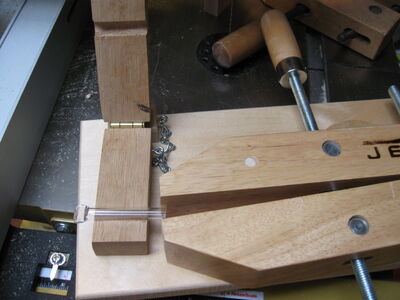
A jig is shown for crimping WAPIs. It works quite well and is simple to use. One jaw of the clamp is secured to the plywood so you just turn the one handle to crimp the end. The little wood holder can be moved so when you are crimping it, you can keep it centered on the clamp.
The SPADE WAPI for bottles
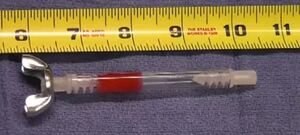
Another technique that has developed from seeking a simple solution to water pasteurization is the SODIS approach. Basically it involves leaving sealed transparent bottles of clear, but untreated, water in direct sunshine from two to four hours. The time will depend on the surfaces below the bottles, and the intensity of the sunshine. Often the bottles are placed on a flat corrugated metal roof. When the water reaches 65°C(150°F) it is suitable for drinking. As mentioned earlier, a need developed to find a simple device, a WAPI, to indicate when the water was safe. Several designs use a melting wax method. A recent version, called the SPADE WAPI, is designed to be fitted directly to the cap on a water bottle. After drilling a 1/4" hole through the cap. The slender clear tube, with wax at one end, is submerged into the bottle. Reaching a safe temperature, the wax runs to the bottom of the tube. A compact approach to providing water pasteurization using existing bottles.
Audio and video

Tusk Trust Documentary - 07 Making Water Safe to Drink
Making Water Safe to Drink with the WAPI.
Disposible soda straw variation
The method described below is included to spark innovation and hasn't been tested for possible chemical contamination from the hot glue.
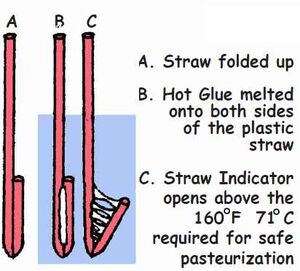
Straw Pasteurizer Indicator - (see above) A disposable pasteurizer indicator invented by Eric Marlow that can be made by taking a plastic soda straw and folding it back on itself and applying hot glue. More information...
See also
- The Boil 3, Add 1 Method allows for the fuel savings of pasteurization (versus sterilization) without the need for a temperature measuring device.
- The Goal is Zero: A Strategy to Eliminate Water-bourne Disease in Lower Nyakach, Kenya, 2013 - Bob Metcalf and FOTO
- WAPI instructions in English, Spanish, and Portuguese
- WAPI production
- SPADE WAPI
- Bob Metcalf
- Water pasteurization
- Portable Microbiology Laboratory
- Integrated Cooking Method
- Report on possible improvements to the WAPI
- Topics needing research


